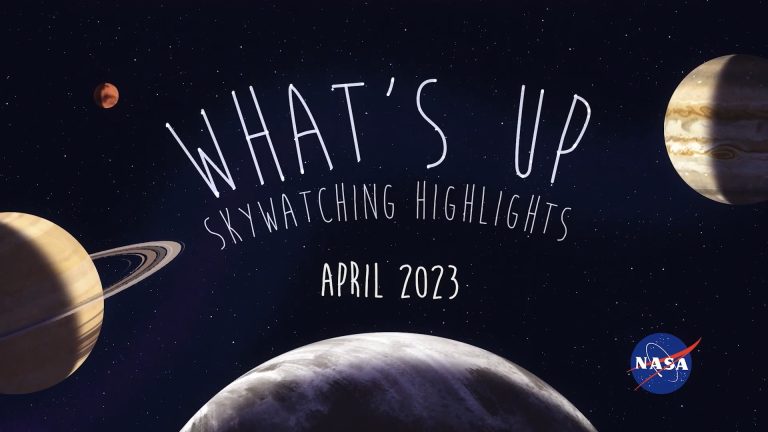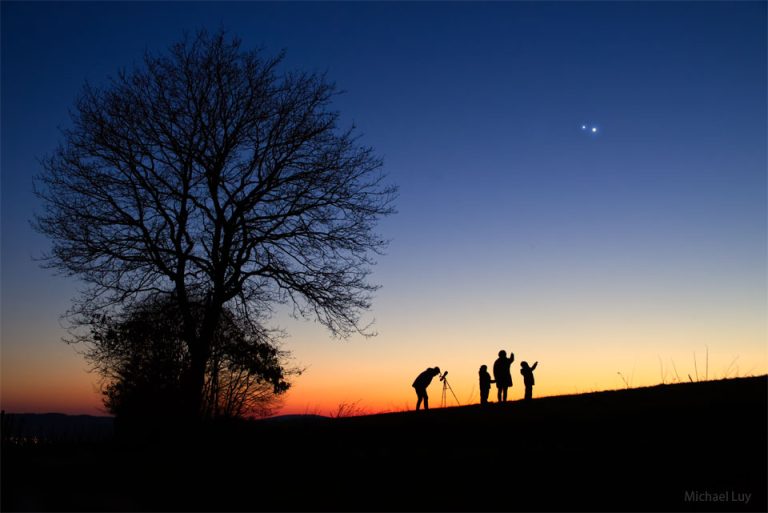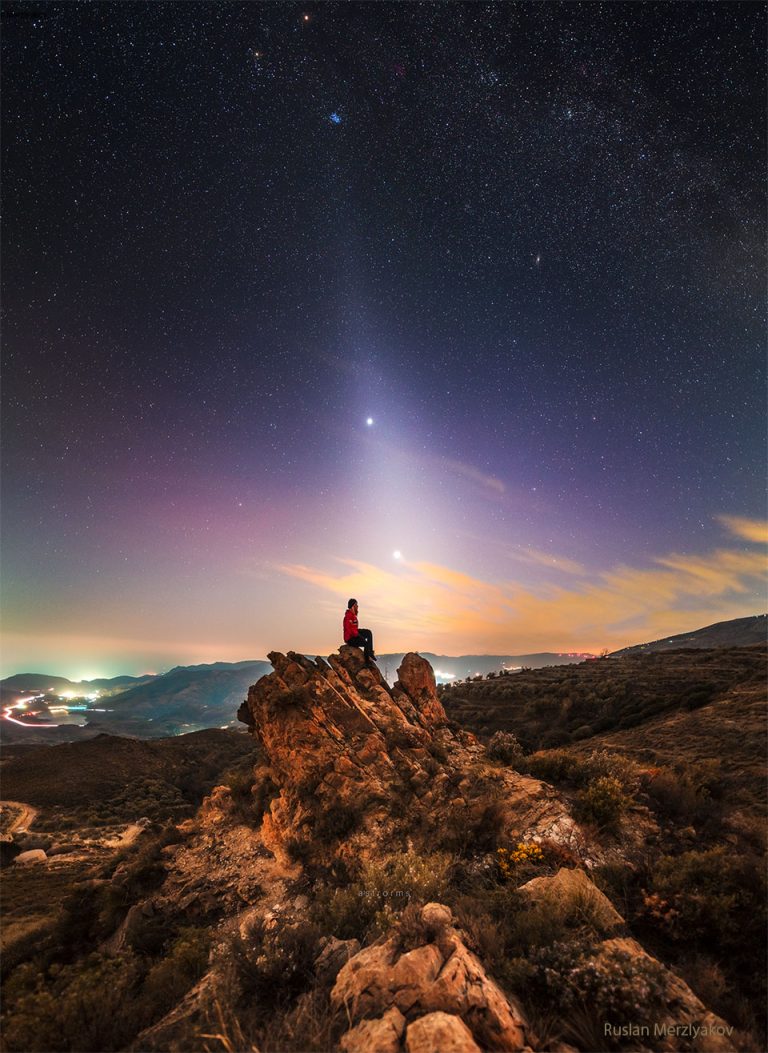观星指南(2023年4月)
4月份的天空会发生什么?水星高升,本月的月亮和行星配对,以及天琴座流星雨。

4月份的天空会发生什么?水星高升,本月的月亮和行星配对,以及天琴座流星雨。

2023年3月25日 Venus and the Da Vinci Glow Image Credit & Copyright: Giorgia Hofer Explanation: On March 23 early evening skygazers could watch Venus and a young crescent moon, both near the western horizon. On that date Earth’s brilliant evening star, faint lunar night side and slender sunlit crescent were captured in this telephoto skyscape posing alongside a church tower from Danta di Cadore, Dolomiti, Italy. Of course the subtle lunar illumination is earthshine, earthlight reflected from the Moon’s night side. A description of earthshine, in terms of sunlight reflected by Earth’s oceans illuminating the Moon’s dark surface, was written over 500 years ago by Leonardo da Vinci. On March 24, from some locations the Moon could be seen to occult or pass in front of…

Maat Mons, a volcano on Venus that has shown signs of a recent eruption, is in the black square near the planet’s equator in this annotated, computer-simulated global map of Venus’ surface. Scientists discovered direct geological evidence of recent volcanic activity on Venus by poring over archival radar images taken over 30 years ago by NASA’s Magellan mission. The images revealed a volcanic vent changing shape and increasing significantly in size in less than a year. Learn more about Maat Mons and NASA’s new mission to study Venus from surface to core. Image Credit: NASA/JPL-Caltech 在这张有注释的、计算机模拟的金星表面全球地图中,金星上的马特蒙斯火山位于赤道附近的黑色正方形中,最近有喷发的迹象。 科学家们仔细研究了30多年前NASA麦哲伦任务拍摄的档案雷达图像,发现了金星最近火山活动的直接地质证据。这些图像显示,在不到一年的时间里,一个火山口的形状发生了变化,规模也在显著扩大。 了解更多关于马特蒙斯火山和NASA从表面到核心研究金星的新任务。 图片来源:NASA/JPL-Caltech

2023年3月15日 Jupiter and Venus Converge over Germany Image Credit & Copyright: Michael Luy (Trier Observatory) Explanation: This was a sky to show the kids. Early this month the two brightest planets in the night sky, Jupiter and Venus, appeared to converge. At their closest, the two planets were separated by only about the angular width of the full moon. The spectacle occurred just after sunset and was seen and photographed all across planet Earth. The displayed image was taken near to the time of closest approach from Wiltingen, Germany, and features the astrophotographer, spouse, and their two children. Of course, Venus remains much closer to both the Sun and the Earth than Jupiter — the apparent closeness between the planets in the sky of Earth…

2023年3月6日 Jupiter and Venus from Earth Image Credit & Copyright: Marek Nikodem (PPSAE) Explanation: It was visible around the world. The sunset conjunction of Jupiter and Venus in 2012 was visible almost no matter where you lived on Earth. Anyone on the planet with a clear western horizon at sunset could see them. Pictured here in 2012, a creative photographer traveled away from the town lights of Szubin, Poland to image a near closest approach of the two planets. The bright planets were then separated only by three degrees and his daughter struck a humorous pose. A faint red sunset still glowed in the background. Jupiter and Venus are together again this month after sunset, passing within a degree of each other about a week…

2023年3月5日 Jupiter and Venus over Italy Image Credit & Copyright: Giovanni Tumino Explanation: What are those two bright spots? Planets. A few days ago, the two brightest planets in the night sky passed within a single degree of each other in what is termed a conjunction. Visible just after sunset in much of the world, the two bright spots were Jupiter (left) and Venus (right). The featured image was taken near closest approach from Cirica, Sicily, Italy. The week before, Venus was rising higher in the sunset sky to meet the dropping Jupiter. Now they have switched places. Of course, Venus remains much closer to both the Sun and the Earth than Jupiter — the apparent closeness between the planets in the sky of Earth…

2023年3月4日 10 Days of Venus and Jupiter Image Credit & Copyright: Soumyadeep Mukherjee Explanation: Venus and Jupiter may have caught your attention lately. The impending close conjunction of the two brightest planets visible in clear evening skies has been hard to miss. With Jupiter at the top, starting on February 21 and ending on March 2, their close approach is chronicled daily, left to right, in these panels recorded from Dhanbad, India. Near the western horizon, the evening sky colors and exposures used for each panel depend on the local conditions near sunset. On February 22, Jupiter and Venus were joined by the young crescent Moon. The celestial pair appeared to be only the width of a full moon apart by March 2. Of course…

3月份的天空会发生什么?金星高高升起,而木星向太阳后方俯冲,还有一颗与你的早餐麦片同名的小行星。

Former NASA astronaut Scott Kelly snapped this photo of the Earth’s crescent, the Moon, Venus, and Jupiter (from top to bottom) on Aug. 6, 2015, while he was aboard the International Space Station. These celestial bodies have been quite close in the night sky; on March 1, Venus and Jupiter were nearest to each other. For more skywatching tips, check out our monthly skywatching guide. 2015年8月6日,NASA前宇航员斯科特·凯利在国际空间站上拍摄了这张月牙形的地球、月球、金星和木星(从上到下)的照片。 这些天体在夜空中离得很近;3月1日,金星和木星距离最近。如欲了解更多观测天空的技巧,请查看我们的月度观星指南。

2023年2月27日 Zodiacal Ray with Venus and Jupiter Image Credit & Copyright: Ruslan Merzlyakov (astrorms) Explanation: What’s causing that unusual ray of light extending from the horizon? Dust orbiting the Sun. At certain times of the year, a band of sun-reflecting dust from the inner Solar System appears prominently after sunset or before sunrise and is called zodiacal light. The dust was emitted mostly from faint Jupiter-family comets and slowly spirals into the Sun. The featured HDR image, acquired in mid-February from the Sierra Nevada National Park in Spain, captures the glowing band of zodiacal light going right in front of the bright evening planets Jupiter (upper) and Venus (lower). Emitted from well behind the zodiacal light is a dark night sky that prominently includes the…